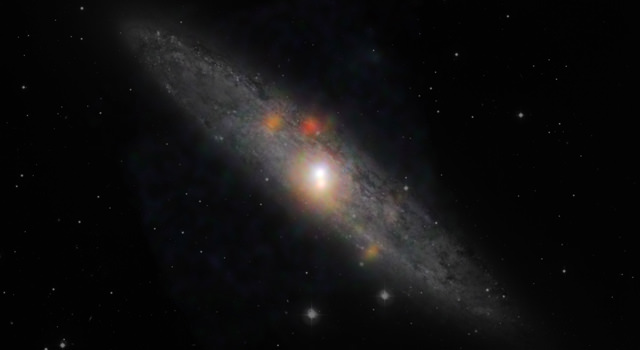The Chandra X-ray Observatory has been keeping an eye on a black hole actively munching away on gas at the middle of the nearby Sculptor galaxy. Now, with the added eyes of the Nuclear Spectroscopic Telescope Array (NuSTAR), which sees higher-energy X-ray light, the observatories have found the black hole has fallen asleep, even amid rampant star-formation going on around it.
“Our results imply that the black hole went dormant in the past 10 years,” said Bret Lehmer of the Johns Hopkins University, Baltimore, and NASA’s Goddard Space Flight Center. “Periodic observations with both Chandra and NuSTAR should tell us unambiguously if the black hole wakes up again. If this happens in the next few years, we hope to be watching.”
Lehmer is lead author of a new study detailing the findings in the Astrophysical Journal.
The now-latent black hole is about 5 million times the mass of our Sun. The Sculptor galaxy (NGC 253) is a so-called starburst galaxy, which is actively giving birth to new stars. At just 13 million light-years away, it is one of the closest starbursts galaxies to us.
Why did the black hole go dormant?
“Black holes feed off surrounding accretion disks of material. When they run out of this fuel, they go dormant,” said co-author Ann Hornschemeier of Goddard. “NGC 253 is somewhat unusual because the giant black hole is asleep in the midst of tremendous star-forming activity all around it.”
“Black hole growth and star formation often go hand-in-hand in distant galaxies,” added Daniel Stern, a co-author and NuSTAR project scientist at the Jet Propulsion Laborator. “It’s a bit surprising as to what’s going on here, but we’ve got two powerful complementary X-ray telescopes on the case.”
Chandra first observed signs of what appeared to be a feeding supermassive black hole at the heart of the Sculptor galaxy in 2003. Then, in September and November of 2012, Chandra and NuSTAR observed the same region simultaneously. NuSTAR, which launched in June of 2012, detected focused, high-energy X-ray light from the region, allowing the researchers to say conclusively that the black hole is not accreting material.
There are two possibilities: either the black hole has in fact gone dormant, or another possibility is that the black hole was not actually awake 10 years ago, and Chandra observed a different source of X-rays. Future observations with both telescopes may solve the puzzle.
The combination of coordinated Chandra and NuSTAR observations is extremely powerful for answering questions like this,” said Lou Kaluzienski, NuSTAR Program Scientist at NASA Headquarters in Washington. “Now, we can get all sides of the story.”
NuSTAR launched into space in June of 2012.
If and when the Sculptor’s slumbering giant does wake up in the next few years amidst all the commotion, NuSTAR and Chandra will monitor the situation. The team plans to check back on the system periodically.
Source: JPL

